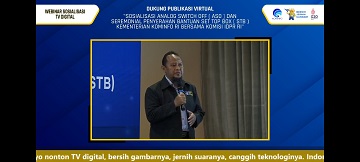
IPB University Physics Lecturer Invites People to Switch to Digital TV Broadcasting Through ASO Socialization
IPB University Physics Lecturer Invites People to Switch to Digital TV Broadcasting Through ASO Socialization
[16 June 2022] Currently, people must immediately switch to digital TV broadcasting to be able to continue enjoying television (TV) broadcasts. This is because the second phase of the cessation of Analog TV Broadcasting (ASO) in August 2022 is imminent. The role of broadcasters, both public and private, is one of the keys to successful migration efforts, especially in socializing the invitation to switch to digital TV broadcasting.
Drs Mahfuddin Zuhri, IPB University lecturer from the Department of Physics participated in the ASO socialization with the Indonesian Ministry of Communication and Information (Kominfo) and the Indonesian House of Representatives Commission, (13/06). On this occasion, he touched on the technical aspects of the Digital TV system.
He said that the signal in a digital system would be easier to process because the magnitude only consists of two values. Not only that, the energy consumption is also relatively smaller than analog TV. Although digital systems have limitations, they far outweigh analog TVs.
“In general, digital systems are easier to design and information is easily stored in digital devices. In the future, much more information will be stored, resulting in smarter devices,” he said.
Digital systems also have greater accuracy and precision. This is because the operation is programmable and relatively resistant to noise caused by interfering signals. The circuit is also easy to fabricate in the form of chips or the size of a fingernail. “In the future, we will have an era where devices and living things are connected to each other through a digital network,” he explained.
The IPB University lecturer explained that the way analog or broadcasting TV systems work is almost similar to Digital TV, the only difference being the type of signal. However, most people still use analog TV. In fact, the reach varies in each region and the quality of the broadcast becomes unstable.
In contrast to digital broadcasts, he said, the quality of broadcasts will not depend on distance and is relatively stable. Not only that, the picture you get will be better, the sound is clearer, and of course more sophisticated. The public can also watch a rebroadcast of an event or get an early warning system in the event of a disaster.
Through this digital system, said Drs Mahfuddin, one frequency can be utilized by many broadcasting stations. So it will be more frequency efficient than analog systems. These frequency savings will also provide more opportunities for other companies to get involved in broadcasting. The remaining frequencies can be used for the development of 5G technology. “With the frequency efficiency, we can develop even better technology, namely 5G technology. This is done by migrating from analog TV technology to digital TV,” he added.
To check whether the TV used can receive digital TV services, the public can do several ways. The first way is by checking the sticker on the back of the TV that says it supports digital viewing or not. In addition, the public can check through the settings menu, usually in the program manager menu there is a DTV (Digital TV) sub menu. The public can also check the TV manual or on the Kominfo website. (MW) IAAS/SYA

This news is previously published in IPB Today


